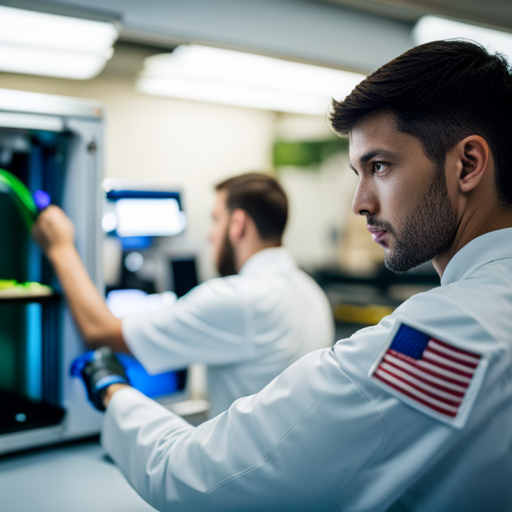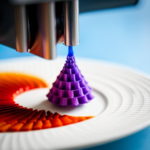In an era of pioneering space exploration, the advent of 3D printing technology has revolutionized the way we approach sustenance for astronauts.
The concept of food 3D printing in space is not just a marvel, but a critical breakthrough in ensuring the well-being of those venturing into the cosmos.
This article delves into the remarkable advancements and implications of 3D printed food for sustaining astronauts on long-duration missions, offering insights into the future of space nutrition.
The Evolution of Space Food
The evolution of space food has been marked by significant advancements in food technology and nutrition science.
In the early days of space exploration, astronauts consumed dehydrated, unappetizing food. However, with the development of space agriculture, growing food in space has become a reality. This has allowed astronauts to have access to fresh produce, improving both the taste and nutritional value of their meals.
Furthermore, food preservation techniques have greatly improved, ensuring that food remains safe and nutritious for extended periods.
Space agriculture, or growing food in space, presents a sustainable solution for long-duration space missions. Techniques such as hydroponics and aeroponics have enabled the cultivation of various crops aboard the International Space Station, reducing the reliance on resupply missions from Earth.
Additionally, advancements in food preservation, such as freeze-drying and irradiation, have extended the shelf life of food without compromising its nutritional content. These developments have not only enhanced the overall quality of space food but have also contributed to the well-being and performance of astronauts in space.
Challenges of Feeding Astronauts
Feeding astronauts in space presents unique challenges that require innovative solutions and careful consideration of nutritional needs and food preparation methods.
The challenges of feeding astronauts in space include:
-
Food Preservation: In space, traditional methods of food preservation such as refrigeration are not feasible due to the absence of gravity. As a result, alternative preservation techniques such as freeze-drying, thermostabilization, and irradiation must be employed to ensure the long-term stability and safety of food.
-
Nutritional Requirements: Meeting the nutritional needs of astronauts in space is crucial for maintaining their health and performance. Space missions require food that provides essential nutrients while being lightweight and compact for easy storage and transportation.
-
Space Agriculture: Developing sustainable space agriculture is essential for long-duration missions. Growing fresh produce in space can provide astronauts with a continuous supply of nutritious food, but it requires overcoming challenges such as limited space, resource management, and the impact of microgravity on plant growth.
Transitioning into the subsequent section about ‘benefits of 3D printed food’, addressing these challenges is vital for ensuring the well-being and productivity of astronauts during space missions.
Benefits of 3D Printed Food
Addressing the challenges of food preservation, nutritional requirements, and space agriculture is vital for ensuring the well-being and productivity of astronauts during space missions. Moreover, the utilization of 3D printed food offers innovative solutions to overcoming these obstacles and provides several distinct benefits for space exploration missions.
One of the key advantages of 3D printed food is customizable nutrition. Astronauts have unique dietary needs, and 3D printing technology allows for the precise control of ingredients, enabling the creation of personalized meals tailored to each astronaut’s specific requirements. This level of customization ensures that astronauts receive the necessary nutrients for optimal health and performance in space.
Additionally, sustainable printing technology is another significant benefit of 3D printed food. Traditional food production and packaging methods can be resource-intensive and generate substantial waste. In contrast, 3D printing uses minimal resources and can produce food with minimal to no waste, making it an environmentally friendly option for space missions with limited resources and storage capacity.
The ability to provide customizable nutrition and utilize sustainable printing technology makes 3D printed food an invaluable asset for sustaining astronauts during extended space exploration missions. Consequently, it is vital to explore the potential of 3D printed food in meeting the nutritional needs of astronauts in space.
Customized Nutrition for Astronauts
As space missions become longer and more extensive, the need for personalized astronaut diets and nutrient-rich printable foods has become increasingly crucial.
Customized nutrition for astronauts is not only about meeting their individual dietary requirements, but also about addressing the specific nutritional needs that may arise during extended space travel.
Personalized Astronaut Diets
Astronauts’ personalized diets are crucial for maintaining their health and well-being during space missions.
-
Personalized Nutrition: Each astronaut has unique dietary requirements based on factors such as age, gender, weight, and specific health conditions. Personalized nutrition plans are tailored to meet these individual needs, ensuring that astronauts receive the right balance of macronutrients and micronutrients for optimal health and performance in space.
-
Customized Meal Plans: Advanced technologies enable the creation of customized meal plans for astronauts, taking into account their nutritional needs, taste preferences, and cultural considerations. These personalized meal plans help mitigate the psychological challenges associated with long-duration space missions and ensure that astronauts receive adequate nourishment for their well-being.
-
Continuous Monitoring: Regular monitoring of astronauts’ health and dietary intake allows for real-time adjustments to their personalized nutrition plans, ensuring that they remain in peak physical condition throughout their mission.
As astronauts’ personalized diets are carefully designed to meet their specific nutritional needs, the subsequent section will delve into the creation of nutrient-rich printable foods for space missions.
Nutrient-Rich Printable Foods
To meet the unique dietary needs of astronauts in space missions, the creation of nutrient-rich printable foods using 3D printing technology is essential. Customizable meals are crucial for providing astronauts with the specific nutrients required for their individual health and performance.
3D printing allows for the precise formulation of food products, enabling the customization of meals based on each astronaut’s dietary needs. Moreover, food safety is paramount in space missions, and 3D printing technology offers the potential to produce shelf-stable, safe foods that meet rigorous safety standards. By utilizing this innovative approach, space agencies can ensure that astronauts receive the necessary nutrition while minimizing the risk of foodborne illnesses.
Consequently, nutrient-rich printable foods not only cater to individual dietary requirements but also contribute to maintaining the overall health and well-being of astronauts in space.
Sustainable Food Solutions in Space
Sustainable food solutions in space require innovative technologies and methods to ensure long-term nutrition for space missions. Achieving this goal involves the implementation of advanced food production techniques and the establishment of space agriculture systems.
Key considerations for sustainable food solutions in space include:
-
Closed-Loop Systems: Developing closed-loop food production systems that efficiently utilize resources and minimize waste is essential for sustainable food solutions in space. These systems encompass processes such as recycling organic waste into fertilizers for cultivating crops, creating a self-sustaining food production cycle.
-
Bioregenerative Life Support Systems: Implementing bioregenerative life support systems that integrate food production with air and water regeneration can significantly contribute to sustainable food solutions in space. This approach involves growing crops that not only provide food but also contribute to the overall life support system by generating oxygen and purifying water.
-
Resource-Efficient Technologies: Utilizing resource-efficient technologies, such as hydroponics and aeroponics, can optimize space agriculture by minimizing water usage and maximizing crop yield. These technologies enable the cultivation of fresh produce in a controlled environment, offering sustainable food solutions for prolonged space missions.
Future Implications for Long-Duration Missions
As we consider the future implications of food 3D printing for long-duration missions, it is crucial to address the sustainability challenges of food production in space.
Additionally, the psychological impact of isolation on astronauts due to limited food variety and freshness must be carefully examined.
These points are essential in shaping the development of food printing technology for the sustenance and well-being of astronauts during extended space missions.
Food Sustainability Challenges
Addressing the challenges of food sustainability in long-duration space missions is imperative for ensuring the well-being and efficiency of astronauts. The future implications for long-duration missions present several food sustainability challenges that need to be addressed:
-
Food Security: Ensuring a stable and reliable food supply for extended space missions is crucial for the physical and mental well-being of astronauts. Limited access to traditional food sources and the inability to rely on resupply missions necessitate the development of sustainable food production systems.
-
Environmental Impact: The production and disposal of food in space can have significant environmental implications. Minimizing waste, energy consumption, and the use of limited resources is essential for long-duration missions to minimize their environmental footprint.
-
Nutritional Adequacy: Providing astronauts with balanced and nutritious meals in space is essential for maintaining their health and performance. Developing sustainable food options that meet all the nutritional requirements for long-duration missions is a critical challenge.
Psychological Impact of Isolation
The psychological impact of isolation presents a significant challenge for the well-being and performance of astronauts on long-duration space missions. Isolation from familiar social environments and support systems can have profound implications for mental health and psychological well-being. Lack of social interaction, limited personal space, and the monotony of the space environment can lead to feelings of loneliness, stress, and anxiety. To mitigate the impact of isolation, astronauts are trained in coping mechanisms such as mindfulness practices, maintaining regular communication with mission control and loved ones, and engaging in recreational activities. However, the prolonged duration of space missions necessitates a deeper understanding of the psychological effects of isolation and the development of strategies to promote mental well-being in astronauts.
| Psychological Impact of Isolation | |
|---|---|
| Mental Health | Loneliness, stress, anxiety |
| Psychological Well-being | Coping mechanisms, mindfulness |
| Social Interaction | Limited, communication with mission control and loved ones |
Innovations in Space Food Technology
In response to the unique challenges of feeding astronauts in space, significant advancements have been made in space food technology. This has led to innovations that address the specific requirements of space nutrition and the limitations of traditional food production in space.
Three notable advancements in space food technology include:
-
3D Printing Advancements: The development of 3D printing technology has revolutionized space food production. It allows for the creation of food with customized nutritional content, textures, and flavors, providing astronauts with a wider variety of food options while also ensuring they receive the necessary nutrients for their health and well-being.
-
Long Shelf-Life Foods: Scientists and food technologists have worked on creating shelf-stable foods that can retain their nutritional value and taste over extended periods. These advancements have enabled the provisioning of long-duration space missions, ensuring that astronauts have access to safe and nutritious food throughout their missions.
-
Enhanced Nutrient Delivery Systems: Efforts have been directed towards developing improved methods of delivering essential nutrients to astronauts. This includes the use of encapsulation techniques and nano-encapsulation to protect sensitive nutrients from degradation, ensuring their availability and efficacy in space environments. These innovations play a crucial role in maintaining the health and performance of astronauts during prolonged space missions.
Frequently Asked Questions
How Does 3D Printing Technology Work in Space and What Are the Specific Challenges of Printing Food in a Microgravity Environment?
3D printing in microgravity presents unique challenges due to altered material behavior and printing conditions. Addressing nutritional needs and ensuring food safety are critical. Technology must adapt to mitigate these challenges for successful food production in space.
What Are the Specific Nutritional Needs of Astronauts and How Does 3D Printed Food Cater to These Needs?
Addressing astronauts’ specific nutritional needs, 3D printed food technology offers a solution in space. It caters to microgravity challenges, ensuring astronaut health. Moreover, it provides flavor and texture while accommodating customized preferences, with long-term implications for Mars colonization.
What Are the Potential Environmental Benefits of 3D Printed Food in Space in Terms of Waste Reduction and Resource Conservation?
The potential environmental benefits of 3D printed food in space include waste reduction and resource conservation. By utilizing precise ingredient measurements and reducing packaging, 3D printing technology minimizes food waste and optimizes resource usage.
How Are the Flavors and Textures of 3D Printed Food in Space Compared to Traditional Space Food, and How Are They Tailored to Individual Astronaut Preferences?
Flavor customization and texture innovation in 3D printed food for space exploration are tailored to individual astronaut preferences while enhancing the eating experience. Compared to traditional space food, these advancements bring heightened sensory satisfaction.
What Are the Potential Long-Term Implications of 3D Printed Food for Future Space Missions, Such as Mars Colonization or Deep Space Exploration?
The potential implications of 3D printed food for future space missions, including Mars colonization and deep space exploration, are significant. Long-term benefits include resource conservation, customized nutrition, and enhanced sustainability, addressing key challenges in extended space travel.
Conclusion
In conclusion, the use of 3D printing technology for food production in space offers numerous benefits, including customized nutrition and sustainable solutions.
As of 2019, NASA has successfully 3D printed meat in space for the first time, marking a significant milestone in space food technology.
This innovation has the potential to revolutionize the way astronauts are fed during long-duration missions, ensuring their nutritional needs are met while exploring the cosmos.


